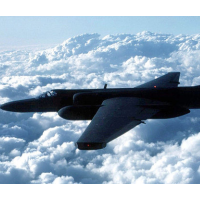Fabled U-2 Spy Plane Begins Farewell Tour by Shutting Down Airports in L.A. Region
 U-2 spy plane (photo: U.S.Air Force / Getty Images)
U-2 spy plane (photo: U.S.Air Force / Getty Images)
The U-2 spy plane hasn't made this big a splash since it was shot down by the Russians in 1960 at the height of the Cold War.
Back then, the U.S. denied we were spying, then admitted we were spying, got back CIA pilot Francis Gary Powers two years later (but not the plane) and the world received its first peek at the future of high-tech government surveillance from the sky.
Andrew Blankstein at NBC reported that the venerable spy plane was not only still flying, it was wreaking havoc in the regional air space surrounding Los Angeles. A few weeks ago, the plane apparently brought all flight activity to a halt in the region when its data stream overwhelmed computers at the L.A. Air Route Traffic Control Center in Palmdale.
The U-2, which was flying way above commercial traffic at 60,000 feet, appeared to somehow be in the flight path of planes nowhere near it, authorities said. The center's En Route Automation Modernization (ENRAM) system, run by the Federal Aviation Administration (FAA), failed, along with backup computers that process data on route requests and flight changes.
The FAA turned everyone away for an hour from Los Angeles International Airport (LAX), and airports in Burbank, Long Beach, Ontario and Orange County. Fifty flights were cancelled at LAX alone and another 428 were delayed. Twenty-seven arrivals were diverted to other airports.
Days later the Los Angeles Times reported that the FAA announced it was increasing the memory of its Palmdale computers and making system adjustments to better sort out altitude information and flight plans.
Although its unknown how often the spy plane enters Southern California air space, it might not be for very much longer. The Pentagon announced in February that it was going to retire the U-2 for budgetary reasons within the next five years. They cost $32,000 an hour to operate.
But the fleet of 32 U-2s was also shot down by drones. The Lockheed-Martin-produced plane has been the heart of U.S. intelligence spy craft for more than 70 years. It beat back a challenge to that position in 2011 by Northrop Grumman and its RQ-4 Global Hawk, a high-altitude surveillance drone. It looked like the expensive Global Hawk and its questionable technology, once considered the certain U-2 successor more than a decade ago, was not going to be picked up.
But after a spirited campaign by Northrop Grumman lobbyists—$31 million for Congress in 2012 and $4 million for campaign contributions—the Global Hawk was back in the 2015 budget.
In 2007, there was a burst of eye-in-the-sky domestic surveillance interest when it was reported that the U-2 had been deployed to help during Hurricane Katrina two years before. Headlines like, “US Turns U-2 Spy Planes On Itself, Raising Specter Of Broader Surveillance” appear almost quaint today with companies vying for contracts to provide surveillance everywhere.
News stories did not mention why the U-2 plane was flying by the region or how often they drop by to visit. The last time a U-2 pilot was known for certain to be flying over Los Angeles was when Francis Gary Powers worked as a helicopter-flying traffic reporter for KNBC in the 1970s. He died in 1977 after covering a brush fire in Santa Barbara County when his helicopter ran out of fuel and crashed in the Sepulveda Basin area.
–Ken Broder
To Learn More:
Spy Plane Fries Air Traffic Control Computers, Shuts Down LAX (by Andrew Blankstein, NBC)
FAA: U-2 Spy Plane Overloaded Computer, Caused Airline Flight Chaos (by Dan Weikel, Los Angeles Times)
Global Hawk Saved, but A-10's Chances Are Dim (by Aaron Mehta, Defense News)
Congress Overrules Pentagon to Fund Northrop Grumman Drones (by Matt Bewig, AllGov)
- Top Stories
- Controversies
- Where is the Money Going?
- California and the Nation
- Appointments and Resignations
- Unusual News
- Latest News
- California Forbids U.S. Immigration Agents from Pretending to be Police
- California Lawmakers Urged to Strip “Self-Dealing” Tax Board of Its Duties
- Big Oil’s Grip on California
- Santa Cruz Police See Homeland Security Betrayal in Use of Gang Roundup as Cover for Immigration Raid
- Oil Companies Face Deadline to Stop Polluting California Groundwater





